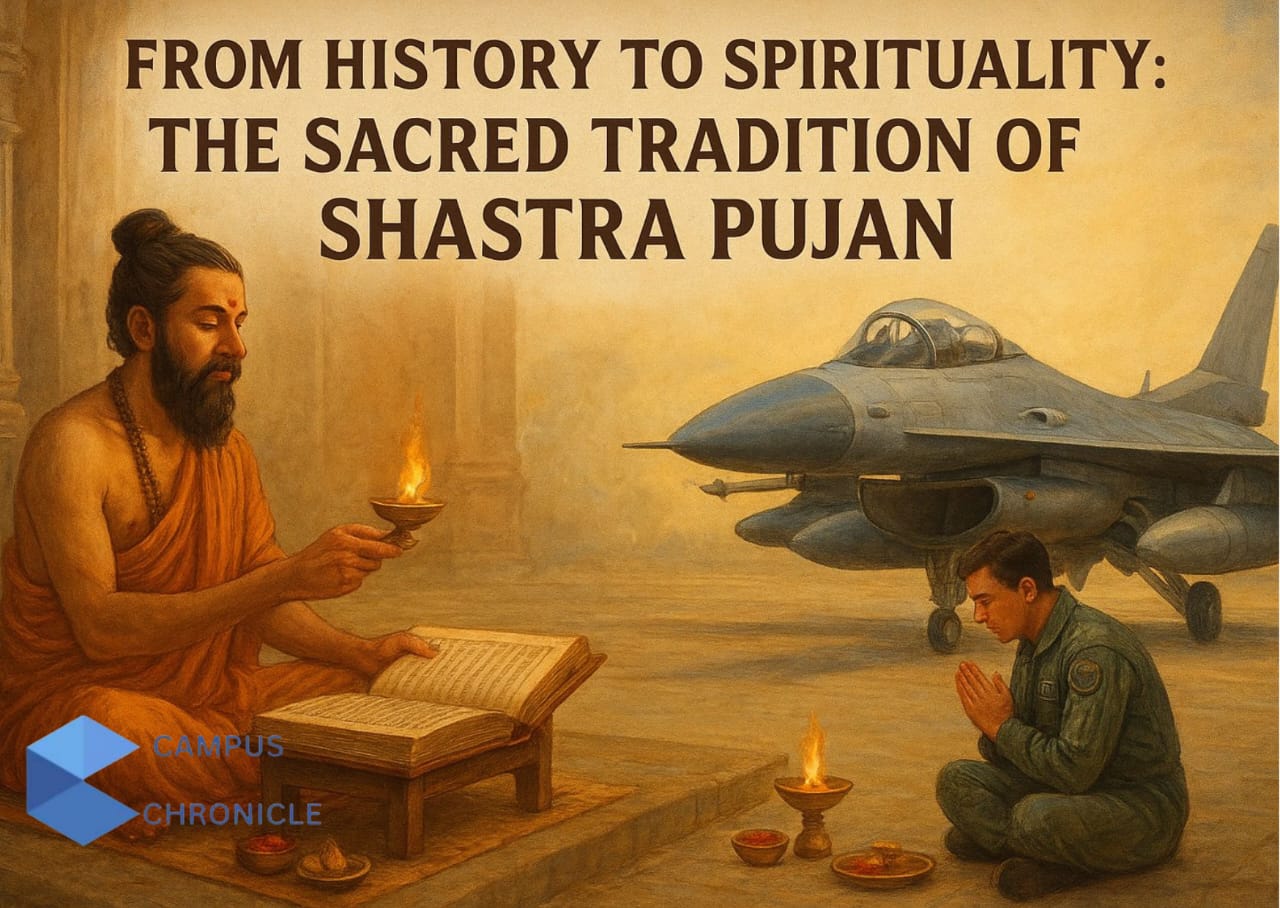Akanksha Singh Sengar
In the kaleidoscope of Hindu traditions, few ceremonies possess the profound synthesis of spirituality, history, and martial ethos as beautifully as Shastra Pujan on Vijayadashami. While most discourse around this sacred observance centers on its ritualistic dimensions, the deeper currents reveal a sophisticated philosophical framework that bridges ancient wisdom with contemporary defense philosophy, a testament to India’s eternal dance between the temporal and transcendental.
The Sacred Architecture of Reverence
The ritual of weapon worship transcends mere ceremonial grandeur; it embodies a metaphysical understanding that tools of protection are extensions of divine will. In the hallowed verses of Hindu scriptures, weapons are not inanimate objects but living manifestations of cosmic energy. When the Bhavishya Purana declares that “anyone who desires victory should worship their weapons on Vijayadashami,” it speaks to a profound recognition that the instrument and the wielder exist in sacred symbiosis.
This reverence finds its most poetic expression in the military traditions where modern warriors apply tilaka to AK-203 rifles and offer coconuts to rocket launchers, transforming steel and circuitry into vessels of divine protection. The sight of Defence Minister Rajnath Singh pressing advanced weaponry to his forehead echoes the ancient understanding that respect for one’s tools is respect for one’s dharma.
The Untold Science of Ancient Metallurgy
Hidden beneath the mythological narratives lies a remarkable story of technological prowess that challenges conventional timelines of human achievement. The worship of weapons during Vijayadashami gains profound meaning when we consider that ancient India produced wootz steel, the legendary material behind Damascus swords, as early as 300 BCE. This crucible steel, created through controlled carburization of iron, exhibited properties that modern metallurgists term “superplastic.”
The Iron Pillar of Delhi stands as silent testimony to this mastery, its rust-resistant qualities achieved through phosphorus content that creates a self-regenerating protective coating, a principle that aligns remarkably with contemporary corrosion science. When ancient warriors worshipped their swords forged from such steel, they were venerating not just weapons but marvels of engineering that wouldn’t be replicated elsewhere for centuries.
The Philosophical Paradox of Sacred Violence
The most intriguing aspect of Shastra Pujan lies in its philosophical complexity, where the celebration of weapons coexists with the principle of ahimsa. This apparent contradiction dissolves when viewed through the lens of dharmic philosophy, where violence is sanctified only when employed for the protection of righteousness. The Bhagavad Gita’s discourse on dharma yuddha reveals that the sacred warrior must achieve a state where “pleasure and pain” and “victory and defeat” become identical in the mind, transforming combat from passionate aggression into transcendent duty.
This psychological framework explains why modern Indian military traditions emphasize that weapons must be wielded “without passion and hatred” but with “restraint” and “calmness.” The ceremony thus serves not as a glorification of violence but as a reminder that those who bear arms must first conquer their own inner demons.
The Mystical Symbiosis: Tree, Time, and Triumph
The incorporation of Shami leaves in weapon worship speaks to an ecological consciousness often overlooked in martial traditions. The Shami tree (Prosopis cineraria), scientifically designed to thrive in arid conditions, becomes a metaphor for resilience in adversity. When the Pandavas retrieved their weapons from this “tree of life” on Vijayadashami, they weren’t just reclaiming metal implements; instead, they were accessing the accumulated strength of nature itself.
This botanical dimension reveals an understanding that military strength must be rooted in harmony with natural forces, a principle increasingly relevant in contemporary discussions about sustainable defense technologies and environmental security.
Modern Resonance in Digital Warfare
As India’s Defense Minister performs Shastra Pujan on drone systems and communication equipment, the tradition reveals its remarkable adaptability. The ceremony now encompasses not just kinetic weapons but the invisible arsenals of cyber warfare, electronic warfare, and artificial intelligence systems. This evolution suggests that the ancients understood something profound about the essence of defensive capability that transcends the physical properties of any particular weapon.
The ritual’s emphasis on seeking “blessings for strength, success, and safety” becomes particularly poignant in an era where warfare increasingly occurs in digital domains where traditional concepts of victory and defeat blur into complex matrices of information superiority and cognitive dominance.
The Global Singularity of Indian Military Culture
Defense Minister Rajnath Singh’s observation that “India is the only country where puja, or worship of weapons, is performed” highlights a unique cultural perspective that treats military preparedness as a spiritual responsibility rather than mere strategic necessity. This approach creates military personnel who understand their role not as wielders of destructive power but as guardians of civilizational values, a mindset that influences everything from rules of engagement to post-conflict reconstruction.
Conclusion: The Eternal Present of Dharmic Defense
Shastra Pujan on Vijayadashami represents more than historical continuity; it embodies a living philosophy that transforms the means of war into instruments of peace. In a world increasingly defined by technological determinism, this ancient tradition reminds us that the human element disciplined by spiritual understanding and guided by dharmic principles remains the decisive factor in any conflict.
The ceremony’s enduring relevance lies not in its preservation of ancient customs but in its capacity to sanctify the terrible responsibility of those who must sometimes employ force to preserve freedom. As modern warriors apply sacred marks to satellites and smart weapons, they participate in a ritual that transforms the machinery of war into the instruments of dharma, ensuring that when India’s weapons speak, they speak not with the voice of conquest but with the authority of justice.
In this synthesis of ancient wisdom and modern capability, we find perhaps the deepest truth about Indian civilization: that progress is not about abandoning the past but about carrying its essential spirit forward into an uncertain future, armed not just with superior technology but with the timeless understanding that true victory lies not in defeating enemies but in upholding the eternal principles that make victory meaningful.





